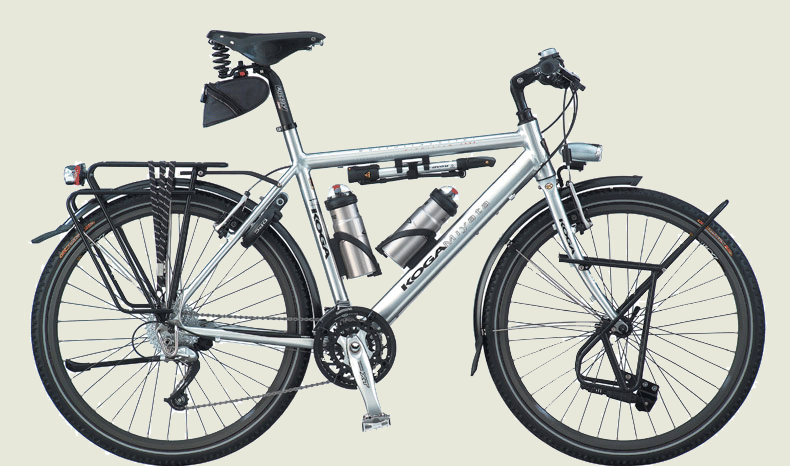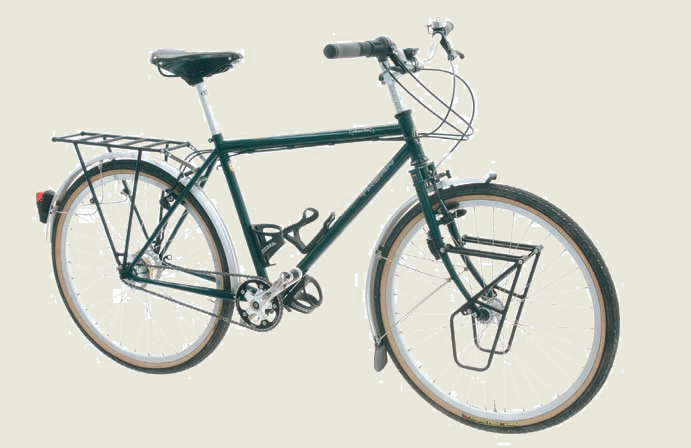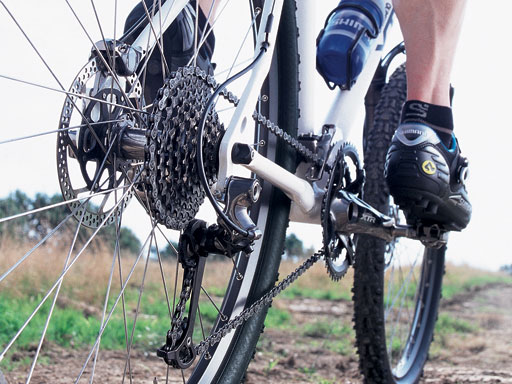| choosing the right bike | the most important choice you'll makehassles ahead?If you're planning a long tour, anything more than a few months, it's probably worth it to invest in a quality touring bike. Touring bikes are specially designed to support the extra weight and stress of heavy baggage. Mountain bikes are not. This is what one cyclist, Rick Gunn, wrote about his equipment: After three years cycling 25,000 miles through 33 countries, I had worn out approximately three bicycle frames, five rear rims, 15 sets of tires, three drive trains and four seats. A bit extreme, but not unusual. I read about one woman who cycled all through Africa on a second-hand mountain bike costing less than 300 euros and had no serious troubles. That's probably the exception. If you read Alastair Humphrey's account of his cycling journey, he had loads of equipment failures, ditto for the South African guy, Rian, who circumnavigated his home continent. what kind of riding will you be doing? Many parts of West and Central Africa are extremely tough on bikes. You'll be riding on rough tracks for much of the time and smooth tarmac will be the exception rather than the rule. If you're cycling in East Africa or Southern Africa your bike doesn't need to be as sturdy because you'll have decent road surfaces for the most part. Cycling in Europe or the Middle East you can count on good tarmac roads so you can easily get away with purchasing a bike of lesser quality. Equipment failures are a hassle and can also be costly if you've got to have spare parts shipped from Europe or the US. Things will break, that's a certainty, but the higher the quality, the fewer worries you'll have. If you're planning a long tour and can afford it, a specially designed expedition bike is the best way to go. These particularly robust touring bikes are purpose-built with people like us in mind. They are designed for carrying heavy loads over rough roads in remote parts of the world. the best bikes for touring Expedition bikes usually have the following features in common:
 We are very satisfied with our Koga Miyata World Travellers. These
bikes are made specifically for cycling expeditions such as ours and
are tough enough to withstand African off-road riding. All components
are Shimano XT, they come with Brooks saddles plus they're already
equipped with Tubus racks. But they are expensive at 2,000 euros. If
you've got the money, it's probably best to invest it in a high quality
bike. We are very satisfied with our Koga Miyata World Travellers. These
bikes are made specifically for cycling expeditions such as ours and
are tough enough to withstand African off-road riding. All components
are Shimano XT, they come with Brooks saddles plus they're already
equipped with Tubus racks. But they are expensive at 2,000 euros. If
you've got the money, it's probably best to invest it in a high quality
bike. The Thorn Raven is
popular with UK based cyclists who swear by them. The latest
model is equipped with an internal hub gear by Rohloff. This
innovative system means minimal maintenance, reduced chain wear and a
single gear changer, rather than the two you normally get.
Tempting, but keep in mind that if something goes wrong in some
far-flung corner of the planet repairs may be impossible. The Thorn Raven is
popular with UK based cyclists who swear by them. The latest
model is equipped with an internal hub gear by Rohloff. This
innovative system means minimal maintenance, reduced chain wear and a
single gear changer, rather than the two you normally get.
Tempting, but keep in mind that if something goes wrong in some
far-flung corner of the planet repairs may be impossible.Like this site? Want to support us as we bike around the world? Just do all your AMAZON shopping through the link below. 
|
| clipless pedals | to clip or not to clip: the battle ragesthe clipless pedal Clipless systems are generally two-sided for touring bikes and mountain bikes. That means you have choice to ride either with the cleated SPD shoes or regular shoes without cleats. Road bikers almost always go clipless. They're interested in speed and appreciate the added efficiency of being locked in to the pedal. Many cyclists insist that once you've used the clipless SPD system, you'll never go back to cycling the old-fashioned way. That wasn't the case for us. The obvious advantage of wearing normal street shoes is that they keep your feet comfortable when you're off the bike and you don't have to carry an extra pair of shoes. And if you'll be traveling through West and Central Africa, keep in mind that you may be doing quite a bit of pushing. the mechanics of clicking in You just position your foot over the pedal and twist and push -"click" and voila - you're "clipped in". don't flip out when you try to clip out Before you set off on your big tour with your new energy saving clipless pedals, try them out while holding onto something. Practice turning the heel out to make the release and then clipping back in until you're comfortable with the new movement. Be patient with yourself, because it will take time before the reaction to click off becomes automatic.  |
| the right saddle | We both ride on Brooks saddles and are extremely satisfied with our choice. |



